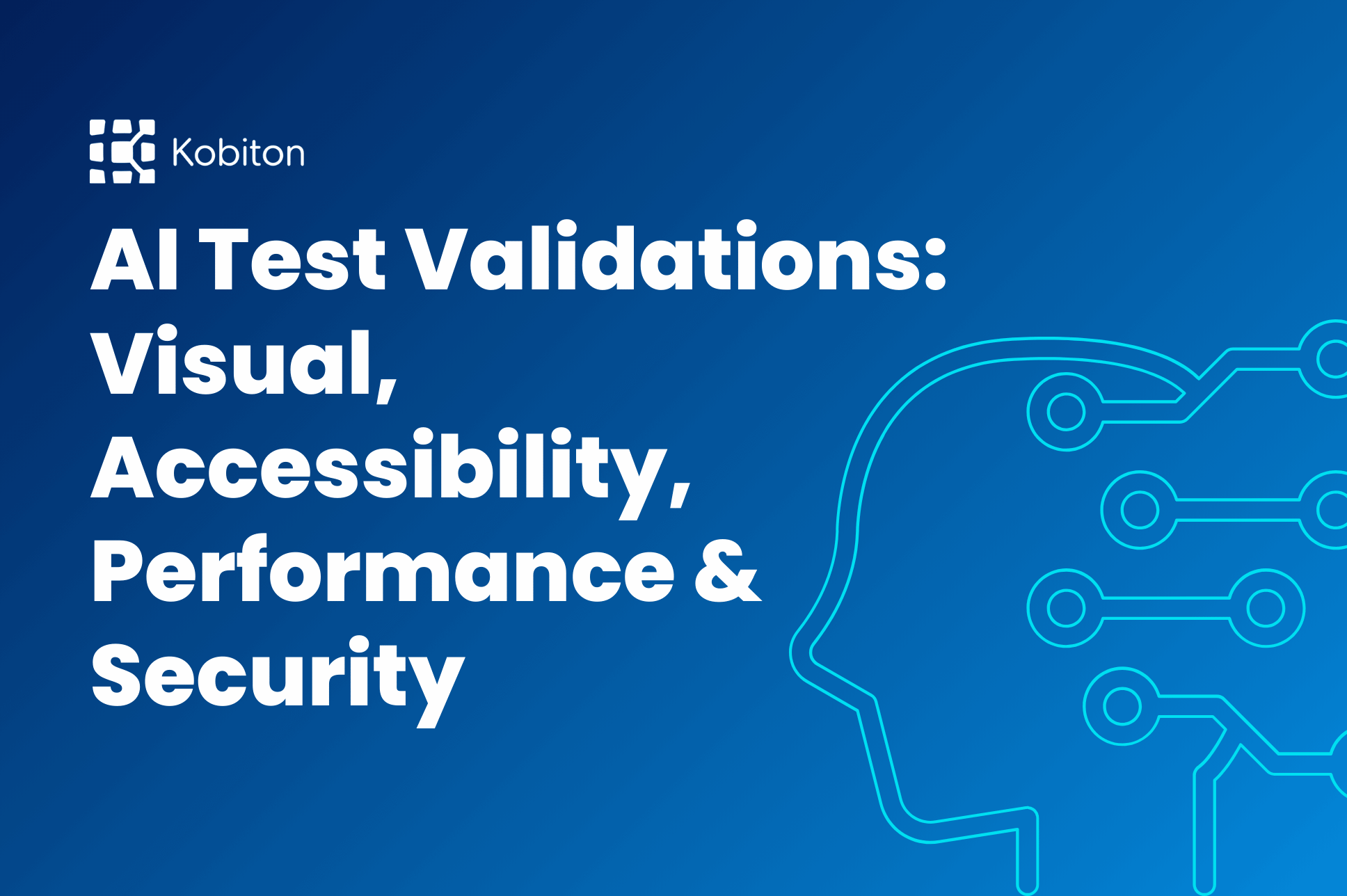
AI-Powered Test Validations: Visual, Accessibility, Performance, and Security

Frank Moyer
In recent years, we’ve witnessed the growing influence of AI in software testing. As product teams struggle to keep pace with increasingly tight release cycles, the role of artificial intelligence has become central to delivering software with both speed and quality. In the broader context of AI test automation, two approaches deserve our attention for how they streamline testing processes: no-code and low-code. These AI-driven capabilities have the potential to revolutionize how we build, maintain, and scale our test suites.
At Kobiton, we’ve been observing this trend closely. AI test automation isn’t just another passing technology fad—it’s fundamentally altering the way software teams think about test coverage, test reliability, and test maintenance. In this article, we’ll explore these approaches in depth. We’ll also discuss how organizations can begin adopting AI-powered testing, connect it to the broader pillar of AI in Testing, and realize significant benefits in product quality and velocity.
When specifically looking at transitioning from script-based test automation to AI test automation it is clear we need a mindset shift. In the past QA teams focused on writing and maintaining test scripts manually. Each script demanded a deep understanding of the application’s codebase, user flows, and business logic. The result was often brittle tests that broke any time the product changed, forcing teams to constantly fix failing tests rather than innovating new ones.
Today, the focus of AI has shifted from only writing test scripts to utilizing AI algorithms for creation, maintenance and healing of test scripts. AI is helping us test differently and better. Product teams can now rely on automated systems to detect changes in the UI, adapt to new element locators, and even generate tests automatically based on observed user behavior or risk analysis. This evolution is particularly evident in two key areas:
Each approach addresses a different set of problems and user needs. Together, they form a powerful toolkit that empowers product teams and QA professionals to move faster, maintain quality, and deliver better software experiences.
No-code test automation solutions cater to product teams who want the benefits of AI in software testing but lack specialized testing or coding expertise. In the past, the challenge with test automation was that you needed specialized engineers to design, develop, and maintain scripts. This technical barrier meant that only those with coding skills could be actively involved in test automation.
By using machine learning models and modern no-code platforms AI is changing that dynamic. AI offers intuitive visual interfaces, so product managers, business analysts, or testers can define user journeys by interacting with the application. The AI platform then transforms these interactions into reusable, maintainable test scripts without a line of code.
For example, a product manager might walk through a signup flow, and the AI-powered no-code tool will automatically capture the steps, element locators, and validations needed to create an automated test. When changes happen—such as modifications to the signup button—the AI engine can detect it and make suggestions for updates. The result is a testing approach that is more accessible, more democratic, and less prone to the traditional brittleness of hand-coded scripts.
From a strategic standpoint, product leaders should consider no-code test automation if they want broader participation in testing efforts. You’re not only incorporating non-technical team members; you’re also freeing up engineering resources to focus on core product development. Additionally, a no-code approach often means quicker onboarding for new tools and faster iteration in test creation.
Low-code test automation solutions occupy a middle ground between no-code platforms and fully scripted approaches. They provide AI-driven automation along with custom scripting. This is especially useful for teams that want customized platforms or to leverage existing technical expertise.
In a low-code environment, your developers or QA engineers have access to both a visual interface and a simplified scripting layer. The AI engine can help by auto-generating test steps or suggesting locators. Allowing testers to insert custom logic or specific validations via concise, high-level code. Think of it as AI-assisted coding, where you only write the minimal code necessary for advanced customizations.
This approach is perfect for teams who have a product that operates on multiple platforms or that has intricate integrations. A purely no-code solution might be too simplistic for such teams. The low-code frameworks assisted by AI allow product teams to quickly build tests while keeping the complexity of customization.
Note: an AI powered low-code strategy can serve as a natural stepping stone for teams that have relied on fully-coded frameworks like Selenium, but want more control over the script. Is there a potential AI will take over script-based frameworks entirely? We will have to watch and see.

Combining no-code and low-code approaches can offer transformative benefits for product organizations. Here’s a quick overview of the key benefits:
AI algorithms drastically reduce the manual work involved in writing and maintaining test scripts. This can reduce your release cycle by weeks, allowing faster product updates and releases.
AI can analyze user behavior, code changes, and historical test data to identify gaps in your test suite. This leads to broader, more robust coverage, helping your team catch critical bugs before they affect users.
Self-healing capabilities lessen time spent fixing broken scripts, allowing teams to focus on higher-value tasks such as exploratory testing and new feature development.
No-code and low-code solutions open the door for cross-functional team members to contribute to automated testing, fostering a culture where everyone owns product quality.
By minimizing manual intervention and accelerating test creation, AI-powered testing solutions can significantly reduce QA spending while still improving product quality.
These advantages align with the broader trend toward AI in software testing, which emphasizes agility, collaboration, and data-driven insights to deliver high-quality products.
While AI-driven test automation offers significant advantages, there are a few downfalls to keep in mind. No-code and low-code solutions may struggle with complex workflows, creating hidden technical debt if not managed properly. Kobiton’s open sourced Appium Script Generator uses generative AI. When test flows are too complex for a no-code solution like Kobiton’s Scriptless Automation, with one click you can generate an Appium script from a manual test and automate more complex flows.
Additionally, AI-powered tools often require access to test data, raising concerns about privacy and compliance—especially in regulated industries. To mitigate these risks, teams should regularly audit AI-generated tests, implement human oversight, and ensure their tools adhere to data security best practices.
For those ready to adopt AI test automation, the journey typically involves a few pragmatic steps:
To dive deeper into how AI in software testing can shape other aspects of your QA and development workflows—such as AI-driven validations, AI-based risk assessment, and tool comparisons—be sure to check out our main pillar blog on AI in Testing. You’ll get a broader overview of the major trends, benefits, and future outlook for this rapidly evolving space.
AI-powered test automation—especially in the realms of no-code, low-code, and self-healing capabilities—is transforming how product teams approach quality. It promises faster time to market, improved coverage, and a substantial reduction in the manual effort required to maintain complex test suites. With the right approach and mindset, product leaders can harness the power of AI test automation to drive meaningful impact in both the short term and the long run.
At Kobiton, we believe that AI is not just an enhancement to existing processes—it’s a catalyst for rethinking how we build and maintain software. As you explore AI test scripts in no-code or low-code environments, remember that self-healing capabilities can serve as the lynchpin that keeps everything running smoothly. The key is to set clear goals, involve the right stakeholders, and remain open to iterative improvements as the technology continues to evolve.
If you’re looking to get started with AI-driven test automation, now is the time. Leverage these innovative approaches and equip your teams to move faster, build better, and delight customers—without sacrificing the quality your organization depends on.